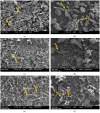Reactive Cellu-mers-A Novel Approach to Improved Cellulose/Polymer Composites
- PMID: 35566839
- PMCID: PMC9103100
- DOI: 10.3390/polym14091670
Reactive Cellu-mers-A Novel Approach to Improved Cellulose/Polymer Composites
Abstract
In this paper, we describe a novel method for preparation of polymer composites with homogeneous dispersion of natural fibers in the polymer matrix. In our approach, Williamson ether synthesis is used to chemically modify cellulose with polymerizable styrene moieties and transform it into a novel multifunctional cellu-mer that can be further crosslinked by copolymerization with styrene. Reactions with model compounds (cellobiose and cellotriose) successfully confirm the viability of the new strategy. The same approach is used to transform commercially available cellulose nanofibrils (CNFs) of various sizes: Sigmacell and Technocell™ 40, 90 and 150. The styrene-functionalized cellulose oligomers and CNFs are then mixed with styrene and copolymerized in bulk at 65 °C with 2,2'-azobisisobutyronitrile as initiator. The resulting composites are in a form of semi-interpenetrating networks (s-IPN), where poly(styrene) chains are either crosslinked with the uniformly dispersed cellulosic component or entangled through the network. Non-crosslinked poly(styrene) (31-41 w%) is extracted with CHCl3 and analyzed by size-exclusion chromatography to estimate the extent of homopolymerization and reveal the mechanism of the whole process. Electron microscopy analyses of the networks show the lack of cellu-mer agglomeration throughout the polymer matrix. The homogeneous distribution of cellulose entities leads to improved thermal and mechanical properties of the poly(styrene) composites compared to the physical mixtures of the same components and linear poly(styrene) of similar molecular mass.
Keywords: cellulose nanofibrils; copolymerization; polymer nanocomposites; polystyrene; semi-interpenetrating networks.
Conflict of interest statement
The authors declare no conflict of interest.
Figures

















References
-
- Hetzer M., De Kee D. Wood/polymer/nanoclay composites, environmentally friendly sustainable technology: A review. Chem. Eng. Res. Des. 2008;86:1083–1093. doi: 10.1016/j.cherd.2008.05.003. - DOI
Grants and funding
LinkOut - more resources
Full Text Sources
Miscellaneous

